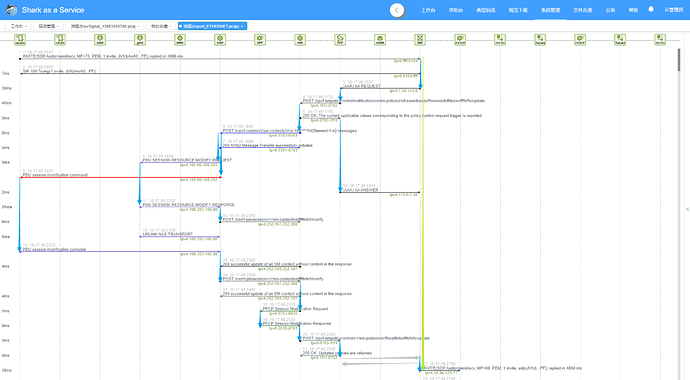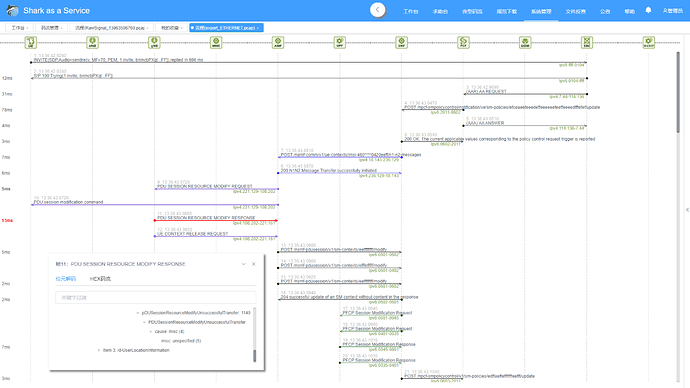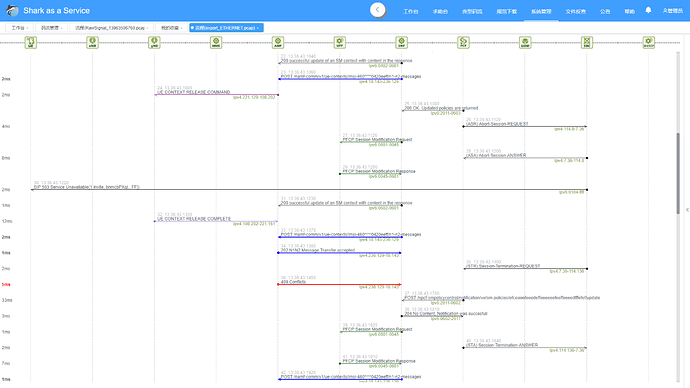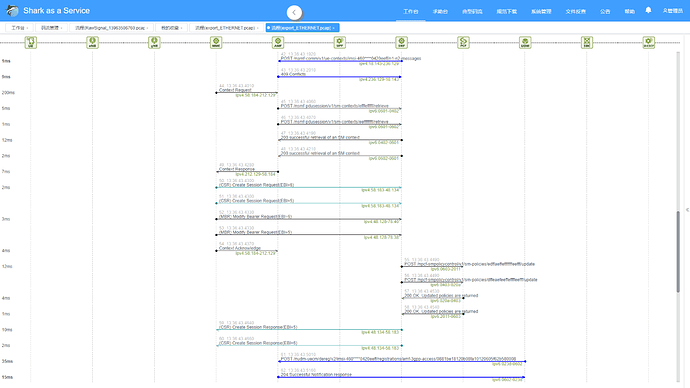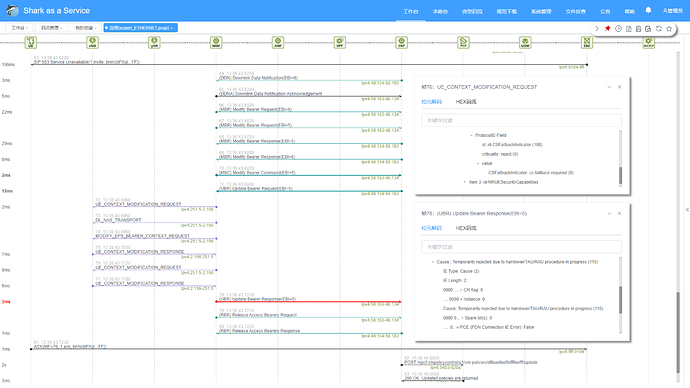Case Scenario:
After initiating a VoNR call, the terminal receives a SIP 503 error, triggering an EPSFB fallback to 4G. Subsequently, it receives another SIP 503 error, leading to a CSFB fallback to 2G/3G.
Before examining this abnormal case, let’s review the normal call initiation process for VoNR.
Then, we will look at the process where the VoNR call initiation fails.
Screenshot 1, frame #1-#21:
The VoNR originator initiates a call, and PCC triggers the SMF/AMF to perform resource reservation. The gNB returns a failure response (#11), with the Cause “misc: unspecified”, prompting the SMF to report “resource allocation failure” to the PCF (#21).
Screenshot 2, frame #22-#42:
While reporting the error, the SMF notifies the AMF/gNB to release the UE context (#24), with the Cause “misc: unspecified”. Upon receiving the report, the PCF reports an ASR (#26) to the SBC/PCSCF, with the AbortCause “INSUFFICIENT_BEARER_RESOURCES” - indicating insufficient bearer resources.
The SBC, familiar with this issue, which was a popular error back in 2016, responds promptly with a SIP 503 (#30) and sends a STR (#35) to the PCF to terminate the session.
Since the UE context is already being released, this SIP 503 cannot be processed, so the SMF notifies the AMF to establish PDU resources (#33 PDU_RES_SETUP_REQ). However, as the UE context has just been released, the AMF responds with a 409 Conflicts (#34), questioning the SMF’s inconsistency. Ignoring this, the SMF continues to send requests (#42 PDU_RES_SETUP_REQ), and the AMF continues to respond with 409 Conflicts (#43).
Screenshot 3, frame #42-#62:
At this point, the MME sends a Context Request to the AMF, indicating that the UE has silently fallen back to 4G (due to the absence of EPSFB switching signaling on a certain signaling platform). The AMF retrieves the context from the SMF (#45, #46) and then returns it to the MME (#49).
Based on the returned context, the MME sends a CSR to the PGW_C (SMF) to create a session (#50, #51). Before the session creation is completed (#59, #60), the MME hastily sends an MBR to modify the bearer to the PGW_C (SMF) (#52, #53), which is clearly inappropriate and premature.
After the session is created (#59, #60), the UDM notifies the AMF to cancel the user’s location registration (#61).
Screenshot 4, frame #63-#83:
By this time, it has been 500ms since the SBC returned a SIP 503 (#30) to the UE, and the SBC retransmits the SIP 503 (#63).
Since the session has just been created and the previous MBR was sent too early, this SIP 503 still cannot be processed. The PGW_C sends a DDN (Downlink Data Notification) to the MME (#64), which responds with a DDNA (Downlink Data Notification Acknowledgement) (#65) and then reinitiates the MBR to the PGW_C (#66-#69).
After the MME completes the MBR (and now the SIP 503 can be processed), it immediately sends an MBC (Modify Bearer Command) to the PGW_C, which responds by initiating a UBR (Update Bearer Request) to the MME (#71).
The MME initiates a context change to the eNB (#72-#75), and then sends another context change (#76), notifying the eNB to perform a CSFB fallback to the circuit domain (due to the absence of the ESR signaling initiated by the UE for CSFB on a certain signaling platform). The UE has just fallen back to 4G; why initiate a CSFB immediately?
After receiving the eNB’s response, the MME returns the execution result of the UBR to the PGW_C (#78): “Temporarily rejected due to handover/TAU/RAU procedure in progress.” This means that the UBR and CSFB procedures conflicted, leading to its rejection.
At this point, before the UE begins the CSFB, it sends an ACK in response to the SIP 503 from the SBC.
Case Summary:
The UE initiates a call in 5G but falls back to 4G due to resource allocation failure. During the 4G CSR/MBR/UBR process, the UBR fails due to a procedure conflict because the UE has already triggered CSFB. The reason for triggering CSFB immediately upon returning to 4G is the SIP 503 error that failed to be acknowledged in 5G but succeeded in 4G!
The UE fails to initiate a call and receives a SIP 503. If it were in 5G, it would perform an EPSFB; if in 4G, it would perform a CSFB. However, this SIP 503 was not acknowledged by the UE in 5G, so it continues to be processed in 4G.
try the flowshark here: http://shark.haohandata.com:20280/
